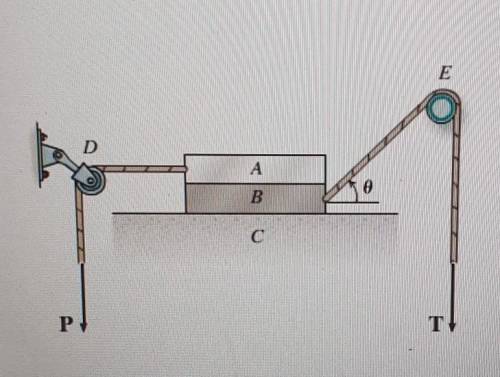
Engineering, 13.01.2021 23:10 bvolleyball9
Blocks A and B have masses 170kg and 270kg, respectively. The coefficient of static friction between A and B and between B and C is 0.300. The coefficient of static friction between the rope and peg E is 0.600. Pulley D rotates freely, and P = 21.0N. If theta = 60°, what is the smallest magnitude, T, of tension, T, that causes block B to move?


Answers: 1


Other questions on the subject: Engineering

Engineering, 04.07.2019 18:10, ashleybaber4966
If a particle moves along a path such that r : (3 sin t) m and ? : 2t rad, where t is in seconds. what is the particle's acceleration in m/s in 4 seconds? a)- 16.43 b)- 16.29 c)- 15.21 d)- 13.79
Answers: 1

Engineering, 04.07.2019 18:10, koolgurl2003
Apump is used to circulate hot water in a home heating system. water enters the well-insulated pump operating at steady state at a rate of 0.42 gal/min. the inlet pressure and temperature are 14.7 lbf/in.2, and 180°f, respectively; at the exit the pressure is 60 lbf/in.2 the pump requires 1/15 hp of power input. water can be modeled as an incompressible substance with constant density of 60.58 lb/ft3 and constant specific heat of 1 btu/lb or. neglecting kinetic and potential energy effects, determine the temperature change, in °r, as the water flows through the pump.
Answers: 1


Engineering, 04.07.2019 18:10, bckyanne3
Afull journal bearing has a journal diameter of 27 mm, with a unilateral tolerance of -0.028 mm. the bushing bore has a diameter of 27.028 mm and a unilateral tolerance of 0.04 mm. the l/d ratio is 0.5. the load is 1.3 kn and the journal runs at 1200 rev/min. if the average viscosity is 50 mpa-s, find the minimum film thickness, the power loss, and the side flow for the minimum clearance assembly.
Answers: 1
You know the right answer?
Blocks A and B have masses 170kg and 270kg, respectively. The coefficient of static friction between...
Questions in other subjects:



Mathematics, 26.08.2019 08:30

English, 26.08.2019 08:30

Mathematics, 26.08.2019 08:30

Chemistry, 26.08.2019 08:30

Computers and Technology, 26.08.2019 08:30



Mathematics, 26.08.2019 08:30



